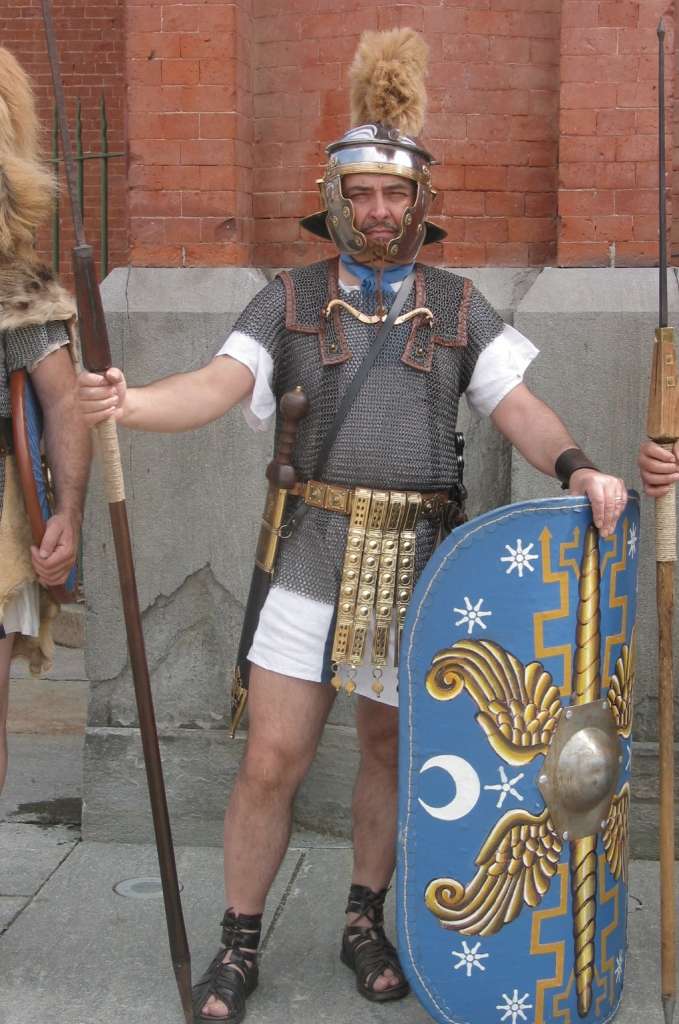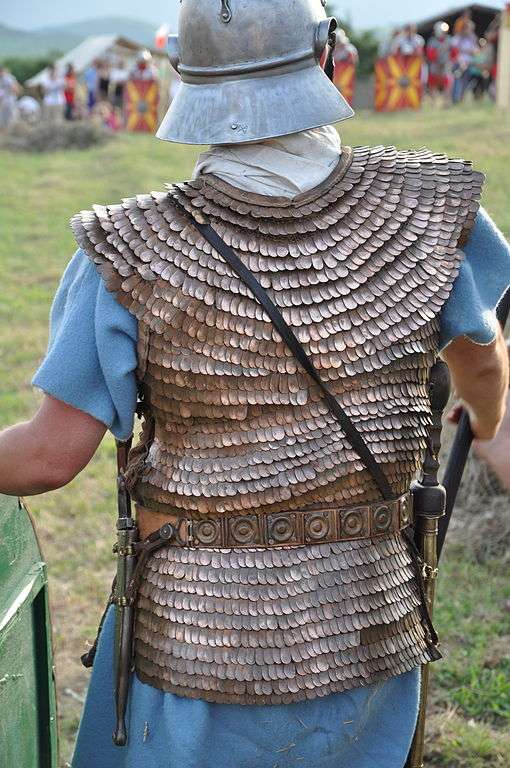This article is part I of a series that will cover some of the more common types of armor worn in ancient Rome. That is not to say that these types of armor were not used by other ancient civilizations (in fact, there is evidence that the Romans took many types of armor from other civilizations). Let’s take a look at the Lorica Segmentata, Lorica Hamata, and the Lorica Squamata.
Lorica Segmentata
Let us start with the armor we often see when referring to Roman soldiers—the one made famous by Russell Crowe’s Maximus Decimus Meridius in the movie Gladiator. This is the overlapping-plated armor that many people believe was the standard armor for all Roman soldiers.
The name lorica segmentata is a more modern invention coming to us through scholars in the 16th century. This is because we have no details about the actual name of this particular piece of armor. As other pieces of armor were called lorica (meaning cuirass), we are relatively certain that this armor was also a lorica. Still, we are not exactly sure what sort of lorica the Romans labeled it.
The lorica segmentata and armor like it can be traced back a few hundred years before the Romans took hold of it, with some accounts placing its first use to around the fourth century BC. The Parthians wore it, while there is a possibility that the Sarmatians, Scythians, and Dacians also used it as they were in contact with one another in antiquity.
We are also not entirely sure when the Romans started using it, but archeological evidence shows they would have had it before the first century AD. We know this because the evidence of the disaster at Teutoburg Forest in AD 9 shows that the Romans were using this type of armor then. The Romans used this armor for at least another three hundred years after, well into the fourth century AD.

As you can see by the image, the lorica segmentata is made up of a few components: the armor plates, the buckles, and the leather straps. There were a few variants of the lorica segmentata, but they all had the same essential components, with the main difference being the positioning of the buckles and straps.
The plates were riveted to straps with the back and front armored plates secured together with brass hinges or clasps over the shoulders. The pieces would also be secured using leather straps on the front and back, tightened to the soldier’s requirements. This would have meant that the armor was in four separate parts (two shoulder and two torso pieces). The way the plates were layered and fastened allowed for flexibility, particularly around the shoulder area, enabling the soldier to fight more freely.
For more information, check out this book Lorica Segmentata Volume I: A Handbook of Articulated Roman Plate Armour, M.C. Bishop, Armatura Press (November 1, 2002) information obtained under Creative Commons Attribution-ShareAlike License 4.0
Lorica Hamata
Lorica hamata is a lot like the medieval chainmail armor. The Romans look to have started using the lorica hamata after coming into contact with the Celts through years of fighting one another. Hamata is derived from the word hamatus, which means hooked due to the rings being hooked together.

The lorica hamata was quite popular due to its flexibility, with the wearer able to move more freely under the small rings of the hamata rather than the plates of the segmentata. However, the fact that the armor was made up of several thousand individual rings meant that it took longer to forge and, therefore, more expensive to produce. In the early days of the empire, only a select few could afford to wear this armor; however, its usage became more widespread in the second century AD.
Lorica Squamata
The Roman scale armor, known as lorica squamata, was quite popular among certain sections of the Roman army – possibly due to its aesthetic look. It was chiefly taken up by the standard bearers (signifers), centurions, and cavalrymen. Not much is known about the history of the armor or when it was popularized by the Romans.

As you can see by the image here, the ‘scales’ were small pieces of metal (generally iron or brass) that were linked or ‘sewn’ together and usually had mail backing. This is often confused with the lamellar armor, which is generally ‘scaled’ but without mail backing. The lorica squamata afforded the soldier more flexibility than the lorica segmentata. However, just like the lorica hamata, it would have been expensive to make due to the time it took to produce.
It must be noted, though, that the Roman army had several types of armor at its disposal at any one time. Due to several factors, including necessity (sudden enemy invasion), shortage of materials, shortage of manpower to produce the armor, and the available funds to produce the armor, not every soldier went into battle wearing the same armor. Many times, the soldiers grabbed whatever they could find at short notice. The soldiers also paid for the armor out of their own pay, so they owned their armor. They aren’t going to be changing the type of armor they wear every time a new variation comes out.
Wearing of the same armor is popularized in Hollywood as it looks better aesthetically. Illustrations usually depict the same armor as well. Even some of the depictions in Roman times are said to be inaccurate and are more propaganda pieces rather than a true reflection of what things looked like out on the battlefield.
To explain this in more detail, take a look at the video below from the YouTube channel Metatron. In it, he explains that the evolution of armor is not linear and that many types of armor were used at the same time in battles. In the video, he is wearing a replica of the lorica segmentata.

